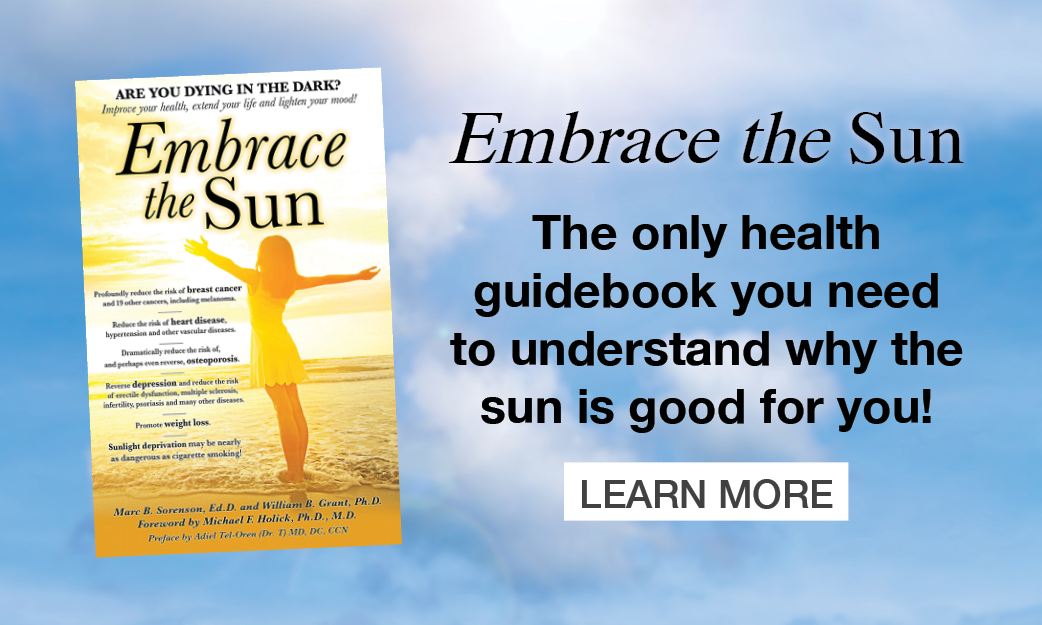Research Studies
Asthma Research:
Sunny hours have a protective effect on the risk of asthma in schoolchildren; the more time in the sunlight, the less the risk of asthma.
http://www.ncbi.nlm.nih.gov/pubmed/20803035
Low sunlight exposure may be the reason for the worldwide epidemic of asthma.
http://www.ncbi.nlm.nih.gov/pmc/articles/PMC3046902/?tool=pubmed
Bowel and Digestive Research:
Low sunlight exposure correlates to high risk of Crohn’s disease.
Cancer Research:
Summer sunlight exposure correlates to a reduced risk of breast cancer among women of any age. Canadian women who spent more than 21 hours per week outdoors had an average risk reduction of 29% compared to those who spent less than 6 hours per week outdoors, and those in the age group 60-74 had a risk reduction of 50%.
http://www.ncbi.nlm.nih.gov/pubmed/21659351
Girls with the greatest exposure to sunlight during the ages of 10-19 had a 35% decreased risk of breast cancer as adults .
http://cebp.aacrjournals.org/content/16/3/422.long
Women who live in the sunniest areas and have the highest exposure to sunlight have a 65% reduction in breast cancer risk compared to those who have the least sunlight exposure.
http://cebp.aacrjournals.org/content/8/5/399.long
Exposure to sunlight and tanning beds correlates to a substantial reduction in the risk of endometrial cancer.
http://www.nature.com/bjc/journal/v101/n3/full/6605149a.html
People who receive more than 5 hours of sunlight exposure on the weekends have a reduced risk of melanoma of 33% compared to those who receive less than 4 hours per day.
http://www.ncbi.nlm.nih.gov/pmc/articles/PMC3046902/?tool=pubmed
Diabetes Research:
Active sun exposure habits are correlated to a lower risk of type-2 diabetes in women.
http://www.diabetesresearchclinicalpractice.com/article/S0168-8227(10)00304-9/abstract
Heart and Vascular Disease Research:
Active sunlight exposure habits correlate to a lower risk of venous clotting in women.
Immune Rystem Research:
Sunlight exposure may improve the immune system with mechanisms other than the effects of vitamin D production.
Multiple Sclerosis (MS) Research:
Low sunlight exposure, combined with the effects of a the Epstein Barr virus, may increase the risk of MS.
http://www.ncbi.nlm.nih.gov/pubmed/21502600
Ultraviolet radiation (also found in sunlight) suppresses experimental MS independent of vitamin D production.
http://www.pnas.org/content/107/14/6418.long
Osteoporosis research:
Women in Spain who actively seek sunlight exposure have a reduced risk of fractures of 91%!
http://www.ncbi.nlm.nih.gov/pubmed/18221637
High sunlight exposure correlates to 77% reductiion in the risk of hip fractures in Alzheimer’s, stroke and Parkinson’s patients.
http://www.ncbi.nlm.nih.gov/pubmed/21682695
Sunlight exposure for one year leads to increased vitamin D levels, increased bone mass and a 73% reduction in the risk of hip fractures among Parkinson’s patients.
http://www.ncbi.nlm.nih.gov/pubmed/21050796
Vision Research:
Several studies show that the greater the amount of outdoor activity in natural light, the less the risk of Myopia.
http://www.ncbi.nlm.nih.gov/pubmed/19211608
http://www.ncbi.nlm.nih.gov/pubmed/21251384
http://www.ophsource.org/periodicals/ophtha/article/S0161-6420(07)01364-4/abstract
http://archopht.ama-assn.org/cgi/content/full/126/4/527
http://informahealthcare.com/doi/abs/10.3109/09286586.2010.508347
- Protect your Skin! More on Nutrition and Sun Exposure. September 24, 2021
- Outdoor activity, Cardiovascular Disease (CVD) and Vitamin D. Is Sun Exposure the real Key for Protection? September 16, 2021
- Another Benefit of moderate, non burning Sun Exposure: any Damage is quickly repaired. September 9, 2021

